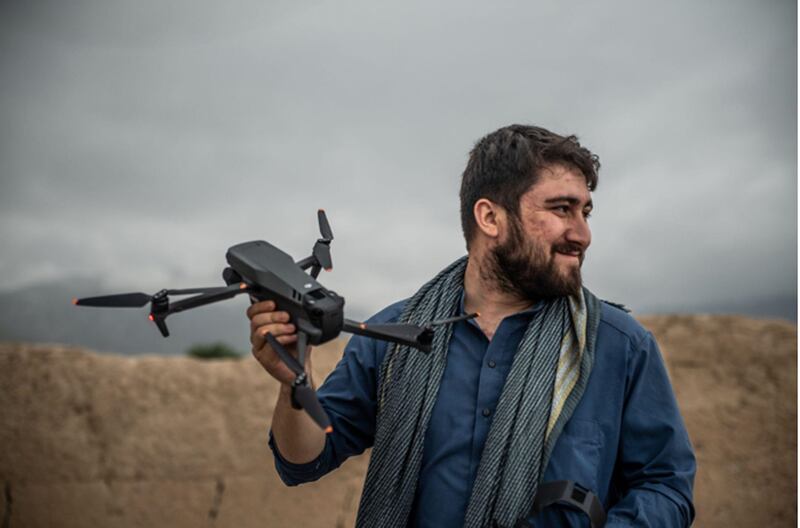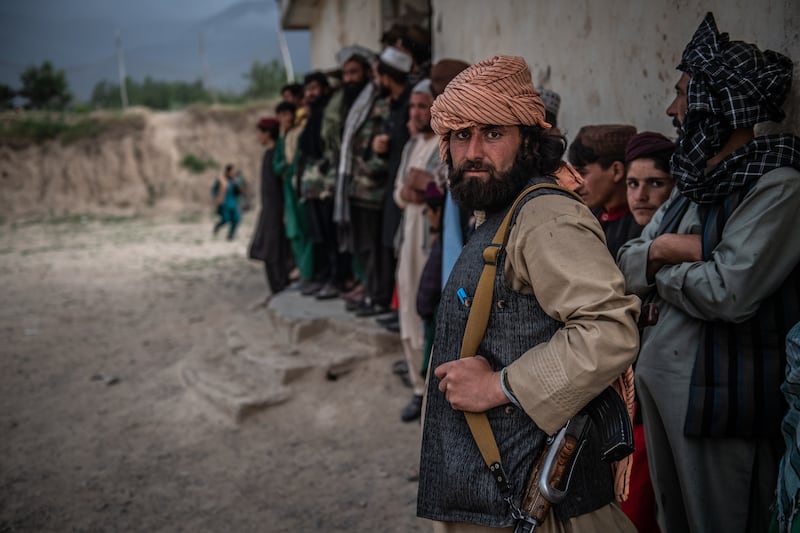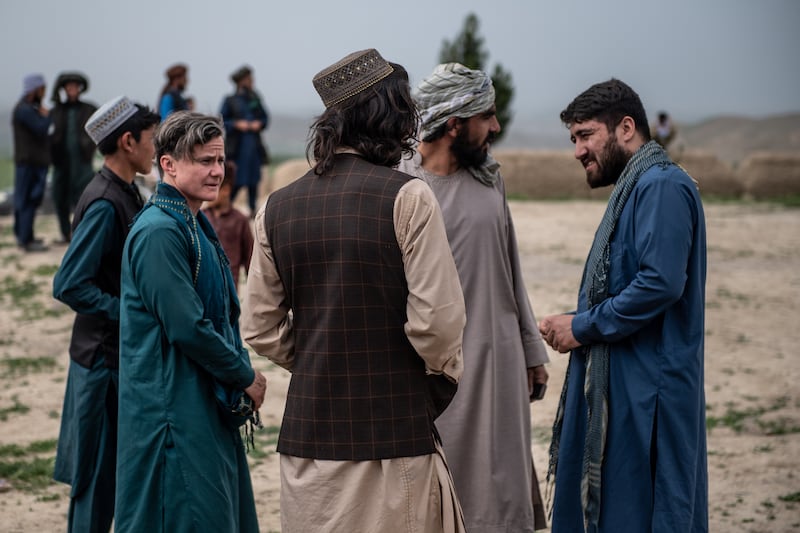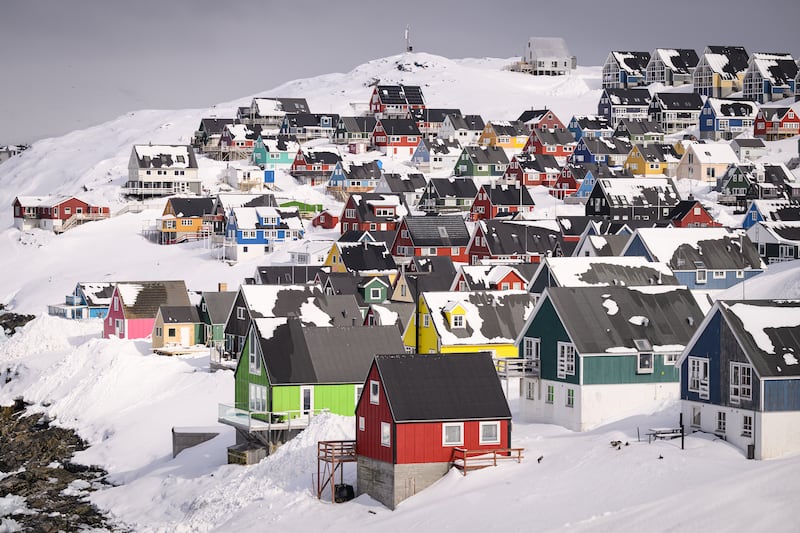In November 2021, a group of young Afghan actors and a production crew gathered at the apartment of the Australian filmmaker and journalist Jordan Bryon in the Qale Fatullah neighbourhood of Kabul.
Three months earlier, the Taliban had retaken control of the Afghan capital in a swift move that marked an end to the US’s 20-year-long military occupation of the country.
Kabul’s burgeoning community of filmmakers had been decimated by the panic-fuelled exodus of educated and connected Afghans, prompted by the militant group’s return. At Bryon’s apartment that November day, The Irish Times was greeted by Farzad Fetrat, one of the few experienced Afghan filmmakers remaining in the city.
Many of the Afghans who filled Bryon’s apartment had only dabbled in film production but they were keen to learn more. “I wanted to inspire people and make them see that we could still make films,” says the 39-year-old Australian. Their initial attempt to shoot a short art film about a couple in the conservative Pashtun city of Kandahar who exchange love notes at a supermarket had been thwarted when the Kabul shop they were using as a set was shut down by locals scared of a possible backlash from the Taliban. “They came on to our set with guns and threatened everyone,” says Bryon. “So we had to pack up and leave.”
Bryon’s balcony was now being used as a makeshift set, with wooden crates piled high and the floor carpeted in red sludge from some 80kg of tomatoes. Bryon explains that the crew had been attempting to emulate the scene from the 1999 film American Beauty, where the protagonist dreams of his love interest on a bed of rose petals – but with tomatoes, rather than flowers. Other filmmakers might have avoided love stories in a city newly controlled by the Taliban, a patriarchal organisation known for its militant brand of religious conservatism. But for Bryon, who had lived in Afghanistan since 2016, the short film was a fleeting form of escapism.
Bryon had started hormone treatment a few months earlier with the help of a doctor in Kabul who – despite coming from the same conservative Pashtun community as the Taliban – provided care to Afghanistan’s tiny LGBTQ+ community
Earlier in the year, Bryon had been reporting from the front lines of the battle between the Afghan national army and the insurgent Taliban for several international outlets. Now, along with Fetrat, Bryon was embedding with an Uzbek Taliban unit in North West Afghanistan in September 2021 for a film for The New York Times. The assignment was fraught with personal danger for both Fetrat, an Afghan without a foreign passport to leave the country easily, and Bryon, a trans man who identifies as queer.

Bryon had started hormone treatment a few months earlier with the help of a doctor in Kabul who – despite coming from the same conservative Pashtun community as the Taliban – provided care to Afghanistan’s tiny LGBTQ+ community.
‘Tragic irony’
Meanwhile, province after province had begun to fall to the Taliban. “The tragic irony of the whole thing is that I was erasing my womanhood by choice and becoming the best person I was at the exact same time and in the exact same place that Afghan women were having their identities erased by force,” says Bryon on a joint Google call with The Irish Times and his co-director and producer Monica Villamizar.
When Kabul fell in August 2021, fellow journalist and filmmaker Villamizar convinced Bryon that they should make a film about how he navigates an Afghanistan in turmoil while undergoing his gender transition. “Traditionally, these kinds of conflicts have been told in a very binary way with an often male perspective,” says Villamizar, speaking to The Irish Times from her home in Virginia.
Last month, Transition premiered at the Tribeca Film Festival in New York. The documentary alternates between nerve-racking footage of Kabul from around the time of the collapse of the government; behind-the-scenes footage of Bryon embedded with the Taliban for the New York Times film (which has not yet been released); and intimate footage of the filmmaker’s transition in Afghanistan and Iran.
In one scene after the fall of Kabul, Bryon looks down from the balcony of his apartment at Taliban fighters swarming around the entrance to his building. Sitting inside, his girlfriend, the Iranian photographer Kiana Hayeri, becomes emotional about Bryon’s refusal to leave: “You as a trans man ending up in an Afghan prison scares the f**k out of me.” Speaking to the camera, Bryon says that as one of the foreign journalists who has built their “reputations and bank accounts off of Afghanistan”, the least he can do is “stick it out when the going gets tough”.

Bryon emphasises that he could not have embedded with the Taliban unit if he was presenting as a woman or had disclosed that he was a trans man. One Taliban fighter who Bryon lived alongside while on assignment said that he would cut his wife’s throat if he heard her voice from the kitchen while men were visiting.
“[Fetrat] and I really struggled a lot with the ethics of making relationships with these people who subscribe to this organisation that we hate,” says Bryon. “At the same time, we did build a very genuine relationship with this one Talib, Mirwais.” In the documentary, the personable Taliban commander Mirwais is keen for the world to see his organisation in a new light. “People think the Taliban are barbaric,” he says, adding that he is “pleased” with the work of Bryon, “an infidel” who “does everything he can to get to know our people and Islam”.
The Taliban fighters in the documentary seem to recognise something different in how Bryon presented: “Jordan looks interesting to me,” says one Talib, while another says that “interesting means kind of beautiful”. “It’s very difficult for Afghans to see this film, because Afghans are still so traumatised from the Taliban taking over,” says Bryon. “They’re not ready for any kind of nuanced narratives.”
While embedded with the Taliban and before undergoing any gender-related surgery, Bryon is challenged to a wrestling match by Mirwais and is playfully picked up by the Taliban commander. Afterwards, Bryon laughs but the stakes involved in the horseplay are high: he or Fetrat could be killed if Byron is discovered to be trans.
‘Power dynamic’
The documentary shows Byron and Fetrat watching footage of the Taliban executing former Afghan police officers and soldiers. “We don’t have anywhere to go… our own people are trying to kill us,” says Fetrat on camera before crying. When Bryon leaves Afghanistan several months later to go to Iran for a breast-removal operation (known as top surgery), he promises to return to help get Fetrat out.

“We were very conscious of this power dynamic [between foreigners and Afghans] from the start,” says Villamizer. “We wanted to put it at the forefront of the film.” In the end, Fetrat leaves Afghanistan with Bryon and two suitcases – “my whole life” – and secures asylum in Germany.
‘If [Taliban commander] Mirwais does find out that I’m trans that will be a conversation that we will have,’ says Bryon. ‘I hope that I have an opportunity to explain everything to him, if he will give me that opportunity’
Bryon’s surgery took place in Iran three months before the mass protests led by women following the death of Mahsa Amini in police custody after she was arrested for allegedly violating Iran’s strict rules requiring women to cover their hair with a hijab. While Bryon had a positive experience in Iran, he’s keen to emphasise that the situation for Iranian trans people is complex. “Gender assignment surgery is legal in Iran but it’s not necessarily socially accepted,” he says. “It really depends on people’s families and communities as to whether they’re accepted or not… Because homosexuality is illegal in Iran, what happens is that a lot of people transition to stay with their loved ones and to avoid being in a same-sex relationship.”
[ Over 460 Afghan people fleeing Taliban permitted to join relatives in IrelandOpens in new window ]
Bryon last embedded with Mirwais’s unit in June 2022 but still regularly exchanges messages with the Taliban commander. “If Mirwais does find out that I’m trans that will be a conversation that we will have,” says Bryon. “I hope that I have an opportunity to explain everything to him, if he will give me that opportunity – definitely from outside of Afghanistan, not inside.”
Now that Transition has been screened, Bryon expects it will be a long time before he can safely return to Afghanistan. “The filmmakers that are left are fighting tooth and nail to continue producing films,” he says, “but obviously the circumstances are extremely difficult.”




















